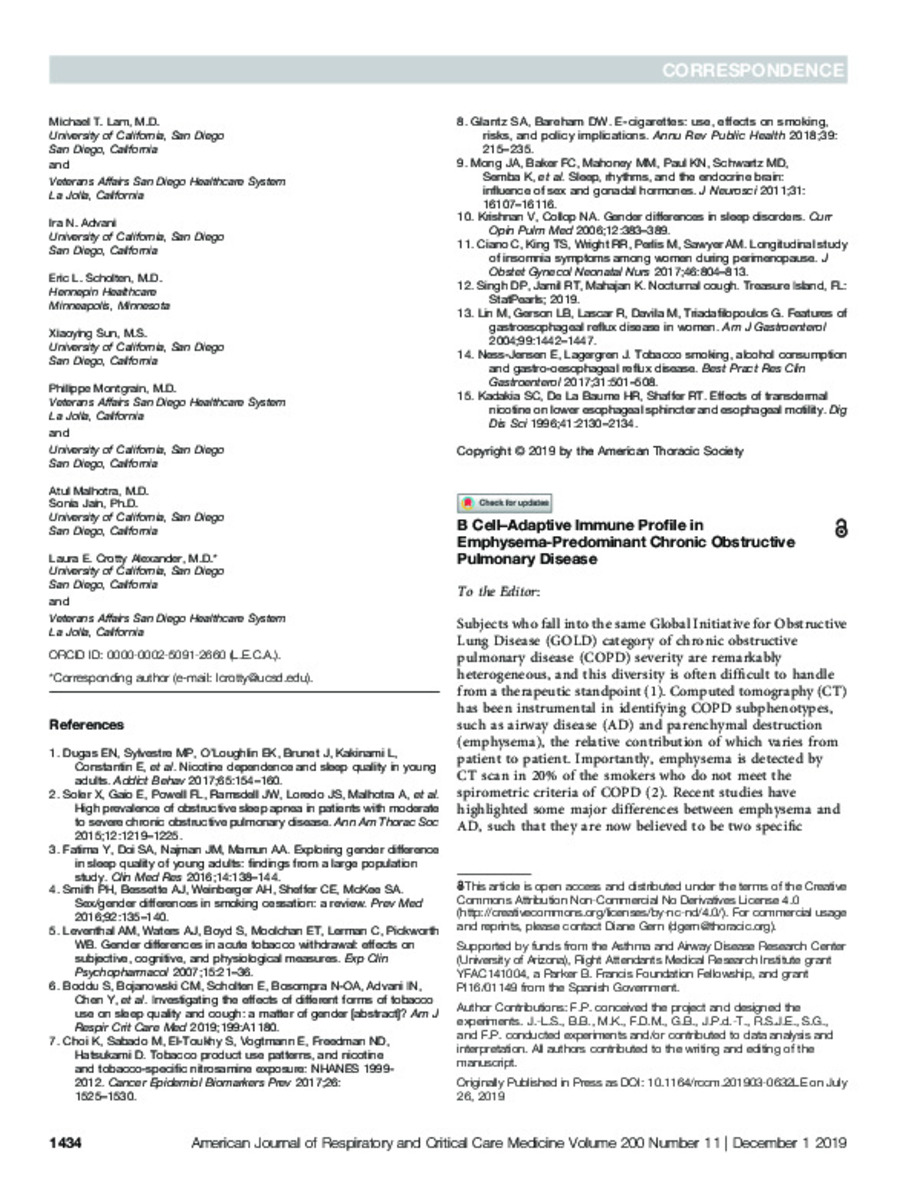Full metadata record
| DC Field | Value | Language |
|---|---|---|
| dc.creator | Sullivan, J.L. (John Lawrence) | - |
| dc.creator | Bagevalu, B. (Bhavani) | - |
| dc.creator | Glass, C. (Carolyn) | - |
| dc.creator | Sholl, L. (Lynette) | - |
| dc.creator | Kraft, M. (Monica) | - |
| dc.creator | Martinez, F.D. (Fernando D.) | - |
| dc.creator | Bastarrika, G. (Gorka) | - |
| dc.creator | Torres, J.P. (Juan P.) de | - |
| dc.creator | San-José-Estépar, R. (Raúl) | - |
| dc.creator | Guerra, S. (Stefano) | - |
| dc.creator | Polverino, F. (Francesca) | - |
| dc.date.accessioned | 2021-11-19T12:30:54Z | - |
| dc.date.available | 2021-11-19T12:30:54Z | - |
| dc.date.issued | 2019 | - |
| dc.identifier.citation | Sullivan, J.L. (John Lawrence); Bagevalu, B. (Bhavani); Glass, C. (Carolyn); et al. "B cell–adaptive immune profile in emphysema-predominant chronic obstructive pulmonary disease". American Journal of Respiratory and Critical Care Medicine. 200 (11), 2019, 31348682 | es_ES |
| dc.identifier.issn | 1073-449X | - |
| dc.identifier.uri | https://hdl.handle.net/10171/62606 | - |
| dc.description.abstract | Cigarette smoke, the major risk factor for COPD in developed countries, causes pulmonary inflammation that persists long after smoking cessation, suggesting self-perpetuating adaptive immune responses similar to those that occur in autoimmune diseases. Increases in the number and size of B cell–rich lymphoid follicles (LFs) have been shown in patients in severe stages of COPD (4), and increased B-cell products (autoantibodies) have been observed in the blood and lungs of patients with COPD (5, 6). Oligoclonal rearrangement of the immunoglobulin genes has been observed in B cells isolated from COPD LFs, suggesting that a specific antigenic stimulation drives B-cell proliferation. Consistently, we have shown that in the COPD lung, there is an overexpression of BAFF (B-cell activation factor of the TNF family), which is a key regulator of B-cell homeostasis in several autoimmune diseases (7) and is involved in the growth of LFs in COPD. However, a network analysis of lung transcriptomics showed that a prominent B-cell molecular signature characterized emphysema preferentially but was absent in AD independently of the degree of airflow limitation (8). In the current study, we investigated the correlation between B-cell responses in lung tissue from patients with COPD and healthy smokers, and the extent of emphysema versus airflow limitation. | es_ES |
| dc.description.sponsorship | Supported by funds from the Asthma and Airway Disease Research Center (University of Arizona), Flight Attendants Medical Research Institute grant YFAC141004, a Parker B. Francis Foundation Fellowship, and grant PI16/01149 from the Spanish Government. | es_ES |
| dc.language.iso | eng | es_ES |
| dc.publisher | American Thoracic Society | es_ES |
| dc.rights | info:eu-repo/semantics/openAccess | es_ES |
| dc.subject | Cigarette smoke | es_ES |
| dc.subject | Pulmonary inflammation | es_ES |
| dc.subject | Smoking cessation | es_ES |
| dc.title | B cell–adaptive immune profile in emphysema-predominant chronic obstructive pulmonary disease | es_ES |
| dc.type | info:eu-repo/semantics/article | es_ES |
| dc.description.note | This article is open access and distributed under the terms of the Creative Commons Attribution Non-Commercial No Derivatives License 4.0 (http://creativecommons.org/licenses/by-nc-nd/4.0/). | es_ES |
| dc.identifier.doi | 10.1164/rccm.201903-0632le | - |
| dadun.citation.number | 11 | es_ES |
| dadun.citation.publicationName | American Journal of Respiratory and Critical Care Medicine | es_ES |
| dadun.citation.startingPage | 31348682 | es_ES |
| dadun.citation.volume | 200 | es_ES |
Files in This Item:
Statistics and impact
Items in Dadun are protected by copyright, with all rights reserved, unless otherwise indicated.






